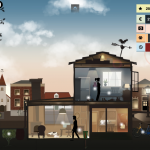Problem Statement
After surgery, patients can experience a delirium. When a patient is in a state of delirium, he/she experiences confusion and disorientation as well as hallucinations. After surgery, while the patient is recovering, nurses can play a critical role in reducing the intensity of the delirium by talking to the patient and placing clues in the room, so the patient knows where he/she is or what day or time it is. The game was designed to give nurses a better understanding of what a delirium is and what and what not to do around a delirious patient.
General Game
The delirium experience is a click-through adventure game interchanged with cut-scenes. The player interface shows a hospital room with a delirious patient lying in bed. The player plays a nurse during the day shift and is able to click on icons allowing to have a conversation with the patient or to change the state of objects in the room, like opening curtains or writing the current day on a whiteboard. The shift ends when the player has used up all of his/her time for the shift. The system calculates whether the delirious state of the patient improves or worsens, based on the player’s decisions and then shows a cut-scene of the delirium from the viewpoint of the patient. The player then plays the next in-game day, and so on.
Specific Game Design Choices
When I joined the team, the basic game design was already in place. We soon decided that a time constraint would represent the limited time nurses can spend with a patient. Based on this new constraint, I recalculated the point system and made a parser to easily import the data into the code.
Reception
The game has yet to be released, but the prospects are good. Below is the trailer for this game.




